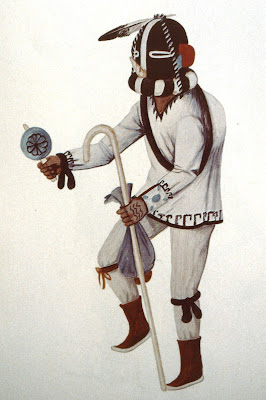Humpbacked flute player, Albuquerque,
NM. Photo: Peter Faris, 1988.
One of the most easily recognized kachinas because of the hump on his back. His black mask has white-rimmed eyes and a white stripe subdividing the face vertically over the top. A conical beak points up which is made of corn husks in real life. He also has feathers or antenna-like protrusions on his head. His name, the Humpback Flute Player, comes from a flute that he carries which may have its end carved in the shape of a flower. He also carries a shepherd’s staff with which to catch girls that he attracts with his flute music or a bag of candy that he carries.
Humpbacked flute player, Mesa Prieta, Rio Arriba county,
NM, Photo Peter Faris, 1997.
Bolder versions of Kokopelli portray him with a large phallus. He is then the personification of nymphomania. Among the Hopi, Kokopelli carries unborn children on his back and distributes them to women (for this reason, young girls often fear him). He often takes part in rituals relating to marriage, and Kokopelli himself is sometimes depicted with a consort, a woman called Kokopellimana by the Hopi.
Some people believe that Kokopelli’s humped back is a pack full of seeds of beneficial and useful plants with which he populates the world. In this incarnation he also presides over the multiplication of game animals. With dominion over agriculture Kokopelli brings the season of Spring by playing his flute to chase away the Winter. The Zuni also associate Kokopelli with the rains.
Assassin fly kachina (Kokopelli).
He is sometimes also called the Robber Fly or Assassin Fly kachina because that insect is humpbacked and has long flute-like mouthparts. Kokopelli frequently appears with a Flute Kachina and sometimes carries no flute until he borrows the flute from the Flute Kachina. When that occurs the Assassin Fly Kachina becomes Kokopelli, the hump-backed flute player.
Assassin Fly Kachina (Kokopelli).
The Assassin Fly or Assassin Bug is an insect with a hump on its back. It is a blood-sucking creature with elongated mouthparts which can easily be seen as the flute. I have had the enlightening experience of being bitten on the back by an assassin bug and it was an experience I would not wish to repeat. The feeling was akin to having a red hot needle shoved into my back. Imagining living the life of a puebloan farmer, spending most of my time in the open, I would be quite aware of the assassin bug, and it could well become a focus of superstition.
Our culture has enthusiastically adopted Kokopelli with the predictable results. We have multiplied sillier and sillier kokopellis, riding bicycles, skiing, playing trombones, etc. I own a few myself given to me as gifts by friends. This may be an inevitable part of our society’s attempt to accommodate, understand, and appreciate another culture, but we should not allow this aspect of the modern kokopelli to make us forget the powerful attributes of fertility and blood which he presented to the people who first conceived of him, and that he represents a sacred image to many of our fellow citizens.








No comments:
Post a Comment